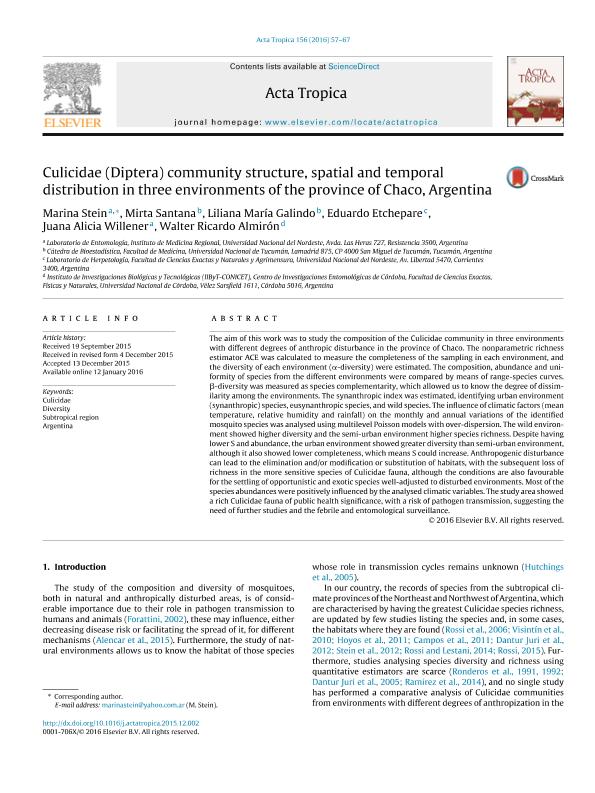Mostrar el registro sencillo del ítem
dc.contributor.author
Stein, Marina

dc.contributor.author
Santana, Mirta Sara

dc.contributor.author
Galindo, Liliana María

dc.contributor.author
Etchepare, Eduardo Gabriel

dc.contributor.author
Willener, Juana Alicia
dc.contributor.author
Almiron, Walter Ricardo

dc.date.available
2018-03-15T21:18:55Z
dc.date.issued
2016-01
dc.identifier.citation
Stein, Marina; Santana, Mirta Sara; Galindo, Liliana María; Etchepare, Eduardo Gabriel; Willener, Juana Alicia; et al.; Culicidae (diptera) community structure, spatial and temporaldistribution in three environments of the province of Chaco, Argentina; Elsevier Science; Acta Tropica; 156; 1-2016; 57-67
dc.identifier.issn
0001-706X
dc.identifier.uri
http://hdl.handle.net/11336/39051
dc.description.abstract
The aim of this work was to study the composition of the Culicidae community in three environments with different degrees of anthropic disturbance in the province of Chaco. The nonparametric richness estimator ACE was calculated to measure the completeness of the sampling in each environment, and the diversity of each environment (α-diversity) were estimated. The composition, abundance and uniformity of species from the different environments were compared by means of range-species curves. β-diversity was measured as species complementarity, which allowed us to know the degree of dissimilarity among the environments. The synanthropic index was estimated, identifying urban environment (synanthropic) species, eusynanthropic species, and wild species. The influence of climatic factors (mean temperature, relative humidity and rainfall) on the monthly and annual variations of the identified mosquito species was analysed using multilevel Poisson models with over-dispersion. The wild environment showed higher diversity and the semi-urban environment higher species richness. Despite having lower S and abundance, the urban environment showed greater diversity than semi-urban environment, although it also showed lower completeness, which means S could increase. Anthropogenic disturbance can lead to the elimination and/or modification or substitution of habitats, with the subsequent loss of richness in the more sensitive species of Culicidae fauna, although the conditions are also favourable for the settling of opportunistic and exotic species well-adjusted to disturbed environments. Most of the species abundances were positively influenced by the analysed climatic variables. The study area showed a rich Culicidae fauna of public health significance, with a risk of pathogen transmission, suggesting the need of further studies and the febrile and entomological surveillance.
dc.format
application/pdf
dc.language.iso
eng
dc.publisher
Elsevier Science

dc.rights
info:eu-repo/semantics/openAccess
dc.rights.uri
https://creativecommons.org/licenses/by-nc-sa/2.5/ar/
dc.subject
Culicidae
dc.subject
Diversity
dc.subject
Subtropical Region
dc.subject
Argentina
dc.subject.classification
Otras Ciencias Biológicas

dc.subject.classification
Ciencias Biológicas

dc.subject.classification
CIENCIAS NATURALES Y EXACTAS

dc.title
Culicidae (diptera) community structure, spatial and temporaldistribution in three environments of the province of Chaco, Argentina
dc.type
info:eu-repo/semantics/article
dc.type
info:ar-repo/semantics/artículo
dc.type
info:eu-repo/semantics/publishedVersion
dc.date.updated
2018-03-09T18:45:18Z
dc.identifier.eissn
1873-6254
dc.journal.volume
156
dc.journal.pagination
57-67
dc.journal.pais
Países Bajos

dc.journal.ciudad
Amsterdam
dc.description.fil
Fil: Stein, Marina. Consejo Nacional de Investigaciones Científicas y Técnicas; Argentina. Universidad Nacional del Nordeste. Instituto de Medicina Regional; Argentina
dc.description.fil
Fil: Santana, Mirta Sara. Universidad Nacional de Tucuman. Facultad de Medicina. Departamento de Investigación. Area de Bioestadística; Argentina
dc.description.fil
Fil: Galindo, Liliana María. Universidad Nacional de Tucuman. Facultad de Medicina. Departamento de Investigación. Area de Bioestadística; Argentina
dc.description.fil
Fil: Etchepare, Eduardo Gabriel. Consejo Nacional de Investigaciones Científicas y Técnicas; Argentina. Universidad Nacional del Nordeste. Facultad de Ciencias Exactas, Naturales y Agrimensura. Departamento de Biología. Laboratorio de Herpetología; Argentina
dc.description.fil
Fil: Willener, Juana Alicia. Universidad Nacional del Nordeste. Instituto de Medicina Regional; Argentina
dc.description.fil
Fil: Almiron, Walter Ricardo. Consejo Nacional de Investigaciones Científicas y Técnicas. Centro Científico Tecnológico Conicet - Córdoba. Instituto de Investigaciones Biológicas y Tecnológicas. Universidad Nacional de Córdoba. Facultad de Ciencias Exactas, Físicas y Naturales. Instituto de Investigaciones Biológicas y Tecnológicas; Argentina
dc.journal.title
Acta Tropica

dc.relation.alternativeid
info:eu-repo/semantics/altIdentifier/url/https://www.sciencedirect.com/science/article/pii/S0001706X15301790
dc.relation.alternativeid
info:eu-repo/semantics/altIdentifier/doi/http://dx.doi.org/10.1016/j.actatropica.2015.12.002
Archivos asociados
